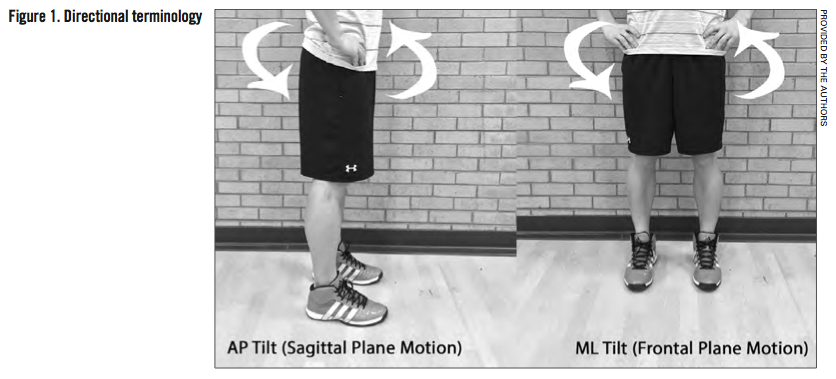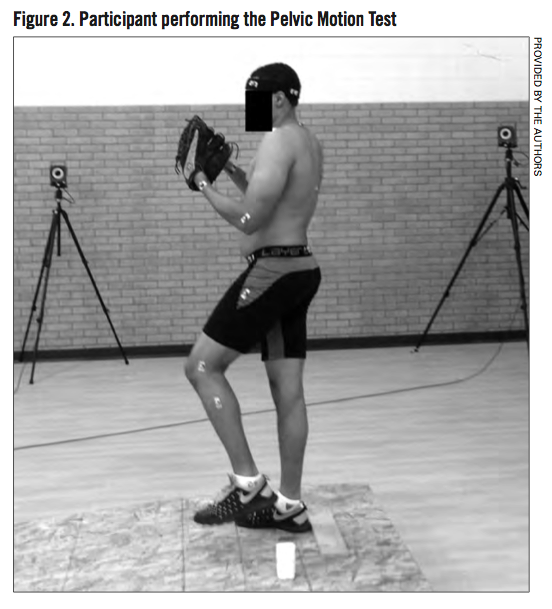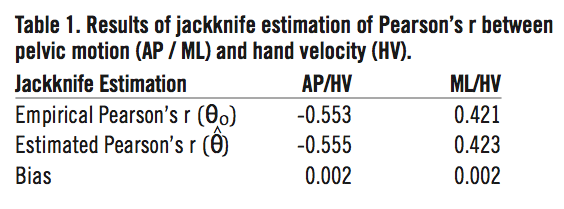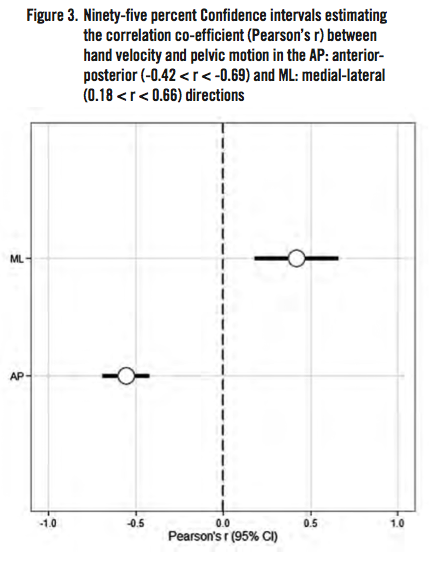Association Between Pelvic Motion and Hand Velocity in College-Aged Baseball Pitchers: A Preliminary Study
This article was written by Eadric Bressel - Talin Louder - William T. Horlbeck
This article was published in Spring 2015 Baseball Research Journal
Baseball pitching is an intricate athletic skill requiring a complex and systematic activation of body segments to create maximal velocity at the distal aspect of the throwing arm.1 The pitching motion can be divided into six phases: (a) wind-up, (b) stride, (c) arm cocking, (d) acceleration, (e) deceleration and (f) follow-through.2 These phases are performed sequentially, and result in mechanical energy transfer through the segments of the kinetic chain, from the lower extremity to the throwing arm.3,4,5
Proper mechanics are crucial for injury prevention and facilitate consistent, successful pitching performance. Previous research suggests that erratic throwing mechanics decrease pitching performance and increase the likelihood of injury.6 Studies that have investigated the pelvic region typically focus on mechanics during the later stages of the pitching sequence.7,8,9,10
Chaudhari et al. investigated the relationship between pelvic motion in the sagittal plane (Fig. 1) during transition from two-foot to single-foot stance and pitcher’s total innings pitched, batting average against, strikeouts per inning, walks per inning, walks plus hits per innings pitched, and days missed due to injury.11,12 These researchers observed that pitchers who exhibited less pelvic motion in the sagittal plane performed better through the course of a season and missed less time due to injury, indicating that pelvic mechanics are crucial to overall performance.13,14 Moreover, a key benefit to the pelvic motion assessment utilized by Chaudhari et al. is the practicality of its implication as a field test to be utilized by coaches who aim to continuously improve pitcher longevity and throwing performance.15,16 While Chaudhari et al. observed an association between pelvic motion in the sagittal plane and performance over the length of a season, the effect of pelvic motion on the pitch itself has not been addressed.17,18 Additionally, while anterior-posterior (AP, Fig. 1) tilt is important, it is only one component of total hip motion. Therefore, the purpose of this study was to investigate the association between a field test assessment of biplanar pelvic motion (AP and medial-lateral (ML, Fig. 1) and hand velocity during the execution of a maximum effort fastball pitch.
Figure 1. Directional terminology
Methods
Participants
Nine National Club Baseball Association pitchers from a university club baseball team served as participants (Age: 21.33 ± 2.45 yrs; Height: 1.84 ± 0.04 m; Mass: 86.13 ± 18.05 kg; Arm Length: 59.75 ± 3.01). Pitchers were free from recent injury and had at least five years of competitive pitching experience.
Data Collection and Analyses
A custom-built pitching mound was constructed to meet National Collegiate Athletic Association (NCAA) baseball regulations. From the mound, pitches were thrown into a net from a distance of 18.4 m. A rectangular target (0.64 m high x 0.38 m wide), with a small square in the middle, was secured onto the net.
Three-dimensional kinematic data were captured using a motion analysis system (Vicon Systems, Centennial, Colorado). Seven Vicon T-20 cameras sampling at 300 Hz tracked retro-reflective markers placed directly on the skin in accordance with the full-body plug-in gait model provided by Vicon. Three-dimensional raw position data were processed using Vicon Nexus software (Vicon Systems, Centennial, Colorado). Gaps were interpolated and data were smoothed using Woltring’s quintic spline routine.19
The order of the pelvic motion test and the hand velocity test was randomized. All participants performed both tests. Prior to testing, participants were allowed unrestricted time to warm up (~10–15 min) as they normally would before a practice or game.
Pelvic Motion Test. Participants performed a modified pelvic motion test where they transitioned from a two-foot to one-foot stance by lifting and holding their kicking leg approximately 10cm above the ground (Fig. 2). Participants repeated this test five times. Using bilateral ASIS and PSIS markers, Nexus defined the pelvis segment with an axis of rotation located at the midpoint between the two ASIS markers. Three-dimensional angular positions were computed for the pelvis segment by Nexus and exported into Excel. For each trial, AP and ML ranges were computed in Excel by taking the difference between the maximum and minimum values for angular position.
Figure 2. Participant performing the Pelvic Motion Test
Pitching Hand Velocity Test. In addition to the warm-up, the participants performed 5 to 10 submaximal pitches to become comfortable pitching with reflective markers attached to their bodies. Once comfortable, pitchers were instructed to throw fastball pitches as fast and as accurate as possible from the wind-up position. They were asked to aim for a small square suspended in the middle of the target box. Participants repeated the pitching test for a total of 5 pitches. A 30–60 second rest was allowed between pitches. Three-dimensional position data for the throwing hand (third metacarpal) were differentiated with respect to time in Nexus, resulting in three-dimensional linear velocities. The three-dimensional velocity data were then exported into Excel and composed into a single, resultant vector for each time point using the Pythagorean Theorem. The maximum value for resultant velocity was selected and normalized to body weight (N) and arm length (cm).
Statistical Analyses
For each participant, five successful pitching trials and five pelvic motion trials were used to compute mean peak pitch velocity and mean pelvic tilt in the frontal and sagittal planes. Prior to statistical analysis, distribution of the data set was assessed using the Shapiro-Wilk test for normality. The Shapiro-Wilk test on mean hand velocity and mean pelvic tilt (AP/ML) revealed no significant deviation from normality. Empirical correlation coefficients (θo) between peak pitch velocity and pelvic tilt (AP/ML) were then computed using the Pearson’s r method. The data sets (AP/Hand Velocity, ML/Hand Velocity) were then resampled using the Jackknife procedure in which single data pairs were excluded sequentially resulting in n estimates for Pearson’s r.20 The mean of resampled correlation coefficients served as an estimate of the true sample correlation (θ ^).21 The distributions of Pearson’s r estimates obtained from resampling were assessed using the Shapiro-Wilk test for normality. The Shapiro-Wilk test on the Pearson’s r estimates revealed no significant deviation from normality. Variances of the Pearson’s r estimates were then estimated using Equation 1.22
Estimated 95 percent confidence intervals for the association between hand velocity and pelvic tilt (AP and ML) were then computed using Equation 2.23
Reliability
Coefficients of variation (Cv=100 ∙ standard deviation/mean) on the sample and inter-trial variability of each participant were computed for hand velocity and both pelvic motion variables.
Results
Mean hand velocity was 8.99 ± 2.27 m∙s-1 ∙ N-1∙cm-1 (Cv = 25%),
Mean AP tilt was 4.99 ± 2.56° (Cv = 51%), and
Mean ML tilt was 8.27 ± 1.79° (Cv = 22%).
Coefficients of variation assessing inter-trial variability ranged from 1% to 4% for hand velocity, 16% to 70% for AP tilt, and 3% to 38% for ML tilt.
Table 1.
Results of the Jackknife estimation of correlation coefficients are presented in Table 1. Based on the estimated 95 percent confidence intervals, we observed a negative correlation between anterior-posterior pelvic tilt and hand velocity (Figure 3) and a positive correlation between ML pelvic tilt and hand velocity (Figure 3).
Figure 3. Ninety-five percent Confidence intervals estimating the correlation co-efficient (Pearson’s r) between hand velocity and pelvic motion in the AP: anterior-posterior (-0.42 < r < -0.69) and ML: medial-lateral (0.18 < r < 0.66) directions
Discussion
We observed a median AP tilt of 7.89°, while Chaudhari et al. reported a median tilt of 7°.24 This is quite similar given the magnitude of movement variability in the pelvic region and the subtle modifications to the pelvic motion test used in the present study. In general, our results support the assertion that the pelvic region is a crucial component of the kinetic chain as evidenced by the plane-specific relationships reported in Figure 3.
Optimizing control and position of the pelvis may contribute to pitching performance and longevity as evidenced by a significant increase in total innings pitched, a significant decrease in time missed due to injury, walks plus hits per innings pitched, as well as improvements in opponents’ batting average, strikeouts per inning, and walks per inning.25,26 Results of this study support this view and, although our predicted confidence intervals are descriptive and should be considered preliminary, they suggest a positive correlation exists between ML tilt and hand velocity, and the opposite for AP tilt.
Conclusion
While preliminary, this study does provide evidence that the pelvis plays an important role in pitching mechanics and performance. The pelvic motion assessment utilized in the present study is a practical field test accessible to coaches aiming to improve upon the longevity and performance of the pitching staff. Also, pitchers and coaches could implement directed practice focusing on pelvic position and motion by providing feedback regarding pelvic position, practicing in front of a mirror, or utilizing video recordings of pelvic motion. n
WILL HORLBECK is a Certified Athletic Trainer and a Certified Strength and Conditioning Specialist. He completed his Master’s Degree in health and human movement at Utah State University in 2014. He is currently working as a personal trainer in Boulder, Colorado, while studying at the University of Colorado at Boulder in pursuit of his physician’s assistant certification.
TALIN LOUDER is a doctoral student at Utah State University in Logan, Utah. He is studying in the Pathokinesiology specialization of the Disability Disciplines PhD program and works as a Presidential Doctoral Research Fellow in Dr. Eadric Bressel’s biomechanics laboratory. His research interests are in sport and clinical biomechanics.
EADRIC BRESSEL is a professor in the health, physical education, and recreation department at Utah State University. He received his B.S. (1994) and M.S. (1995) in exercise science from California State University, Fresno, and he received his EdD in biomechanics from the University of Northern Colorado (1999). His research examines neuromechanical adaptations to therapeutic exercise, anatomical and biomechanical determinants of Achilles tendon rupture, and neuromechanics of cycling. He is a member of the American and International Societies of Biomechanics and of the American College of Sports Medicine.
REFERENCES
Chaudhari, Ajit MW, Christopher S. McKenzie, James R. Borchers, and Thomas M. Best. “Lumbopelvic Control and Pitching Performance of Professional Baseball Pitchers.” The Journal of Strength & Conditioning Research 25, no. 8 (2011): 2127–32.
Chaudhari, Ajit MW, Christopher S. McKenzie, Xueliang Pan, and James A. Oñate. “Lumbopelvic Control and Days Missed Because of Injury in Professional Baseball Pitchers.” The American Journal of Sports Medicine (2014): 0363546514545861.
Fleisig, Glenn S., The Biomechanics of Baseball Pitching (Unpublished doctoral dissertation). University of Alabama at Birmingham, Birmingham, AL (1994).
Fleisig, Glenn S., James R. Andrews, Charles J. Dillman, and Rafael F. Escamilla. “Kinetics of Baseball Pitching with Implications about Injury Mechanisms.” The American Journal of Sports Medicine 23, no. 2 (1995): 233–39.
Fleisig, Glenn S., Steve W. Barrentine, Nigel Zheng, Rafael F. Escamilla, and James R. Andrews. “Kinematic and Kinetic Comparison of Baseball Pitching Among Various Levels of Development.” Journal of Biomechanics 32, no. 12 (1999): 1371–75.
Seroyer, Shane T., Shane J. Nho, Bernard R. Bach, Charles A. Bush-Joseph, Gregory P. Nicholson, and Anthony A. Romeo. “The Kinetic Chain in Overhand Pitching: Its Potential Role for Performance Enhancement and Injury Prevention.” Sports Health: A Multidisciplinary Approach 2, no. 2 (2010): 135–46.
Stodden, David F., Glenn S. Fleisig, Scott P. McLean, and James R. Andrews. “Relationship of Biomechanical Factors to Baseball Pitching Velocity: Within Pitcher Variation.” J Appl Biomech 21, no. 1 (2005): 44-56.
Stodden, David F., Glenn S. Fleisig, Scott P. McLean, Stephen L. Lyman, and James R. Andrews. “Relationship of Pelvis and Upper Torso Kinematics to Pitched Baseball Velocity.” Journal of Applied Biomechanics 17, no. 2 (2001): 164–72.
Wight, Jeff, James Richards, and Susan Hall. “Baseball: Influence of Pelvis Rotation Styles on Baseball Pitching Mechanics.” Sports Biomechanics 3, no. 1 (2004): 67–84.
Wilk, Kevin E., Keith Meister, Glenn Fleisig, and James R. Andrews. “Biomechanics of the Overhead Throwing Motion.” Sports Medicine and Arthroscopy Review 8, no. 2 (2000): 124–34.
Woltring, Herman J. “A FORTRAN Package for Generalized, Cross-Validatory Spline Smoothing and Differentiation.” Advances in Engineering Software (1978) 8, no. 2 (1986): 104–13.
Zhou, Xiao-Hua, Nancy A. Obuchowski, and Donna K. McClish. Statistical Methods in Diagnostic Medicine. Vol. 712. John Wiley & Sons, 2011.
Notes
1. Kevin Wilk, “Biomechanics of the overhead throwing motion.” Sports Medicine and Arthroscopy Review 8, no. 2 (2000): 124–34.
2. Glenn Fleisig. “Kinetics of baseball pitching with implications about injury mechanisms.” The American Journal of Sports Medicine 23, no. 2 (1995): 233–39.
3. Ajit Chaudhari. “Lumbopelvic control and pitching performance of professional baseball pitchers.” The Journal of Strength & Conditioning Research 25, no. 8 (2011): 2127–32.
4. Ajit Chaudhari. “Lumbopelvic control and days missed because of injury in professional baseball pitchers.” The American Journal of Sports Medicine (2014): 2734–40.
5. Shane Seroyer. “The kinetic chain in overhand pitching: its potential role for performance enhancement and injury prevention.” Sports Health: A Multidisciplinary Approach 2, no. 2 (2010): 135–46.
6. Glenn Fleisig. “Kinematic and kinetic comparison of baseball pitching among various levels of development.” Journal of Biomechanics 32, no. 12 (1999): 1371–5.
7. Glenn Fleisig. The biomechanics of baseball pitching (Unpublished doctoral dissertation). University of Alabama at Birmingham, Birmingham, AL (1994).
8. David Stodden. “Relationship of pelvis and upper torso kinematics to pitched baseball velocity.” Journal of Applied Biomechanics 17, no. 2 (2001): 164–72.
9. David Stodden. “Relationship of biomechanical factors to baseball pitching velocity: within pitcher variation.” Journal of Applied Biomechanics 21, no. 1 (2005): 44–56.
10. Jeff Wight. “Baseball: Influence of pelvis rotation styles on baseball pitching mechanics.” Sports Biomechanics 3, no. 1 (2004): 67–84.
11. Chaudhari. “Lumbopelvic control and pitching performance of professional baseball pitchers.” 2127–32.
12. Chaudhari. “Lumbopelvic control and days missed because of injury in professional baseball pitchers.” 2734–40.
13. Chaudhari. “Lumbopelvic control and pitching performance of professional baseball pitchers.” 2127–32.
14. Chaudhari. “Lumbopelvic control and days missed because of injury in professional baseball pitchers.” 2734–40.
15. Chaudhari. “Lumbopelvic control and pitching performance of professional baseball pitchers.” 2127–32.
16. Chaudhari. “Lumbopelvic control and days missed because of injury in professional baseball pitchers.” 2734–40.
17. Chaudhari. “Lumbopelvic control and pitching performance of professional baseball pitchers.” 2127–32.
18. Chaudhari. “Lumbopelvic control and days missed because of injury in professional baseball pitchers.” 2734–40.
19. Herman Woltring. “A FORTRAN package for generalized, cross-validatory spline smoothing and differentiation.” Advances in Engineering Software (1978) 8, no. 2 (1986): 104–13.
20. Xiao-Hua Zhou. Statistical Methods in Diagnostic Medicine. Vol. 712. John Wiley & Sons, 2011.
21. Ibid.
22. Ibid.
23. Ibid.
24. Chaudhari. “Lumbopelvic control and pitching performance of professional baseball pitchers.” 2127–32.
25. Ibid.
26. Chaudhari. “Lumbopelvic control and days missed because of injury in professional baseball pitchers.” 2734–40.








